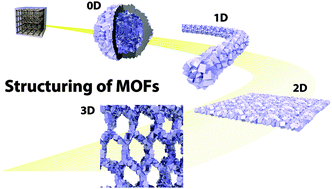Structuring of metal–organic frameworks at the mesoscopic/macroscopic scale
Abstract
The assembly of metal ions with organic ligands through the formation of coordination bonds gives crystalline framework materials, known as metal–organic frameworks (MOFs), which recently emerged as a new class of porous materials. Besides the structural designability of MOFs at the molecular length scale, the researchers in this field very recently made important advances in creating more complex architectures at the mesoscopic/macroscopic scale, in which MOF nanocrystals are used as building units to construct higher-order superstructures. The structuring of MOFs in such a hierarchical order certainly opens a new opportunity to improve the material performance via design of the physical form rather than altering the chemical component. This review highlights these superstructures and their applications by categorizing them into four dimensionalities, zero-dimensional (0D), one-dimensional (1D), two-dimensional (2D), and three-dimensional (3D) superstructures. Because the key issue for structuring of MOFs is to spatially control the nucleation process in desired locations, this review conceptually categorizes the available synthetic methodologies from the viewpoint of the reaction system.

- This article is part of the themed collection: Metal Organic Frameworks (MOFs)

 Please wait while we load your content...
Please wait while we load your content...